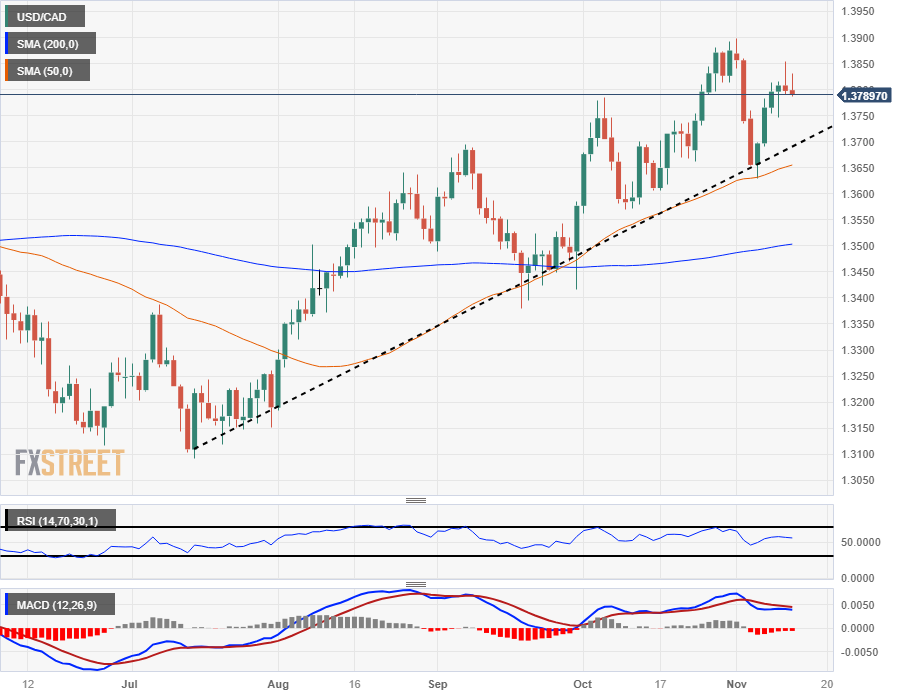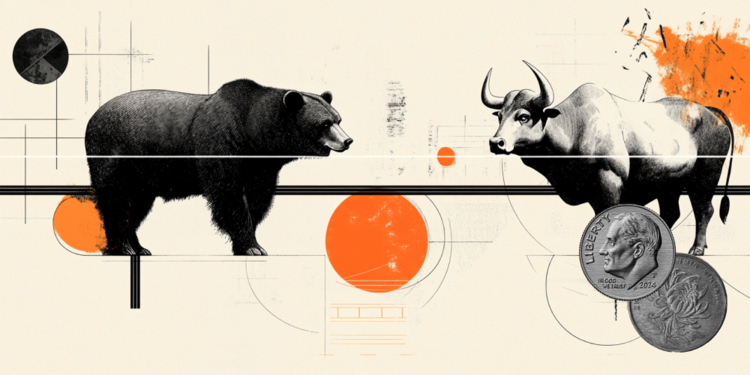- The Canadian dollar is adrift in a sluggish market at the start of the trading week.
- The Remembrance Day holiday in Canada has most provinces out of the office on Monday.
- The economic calendar is thin this week, with little Canadian data on offer.
He Canadian dollar (CAD) is finding little traction in thin holiday markets, with most Canadian provinces and territories taking the day off in observance of Remembrance Day.
The economic data agenda for the CAD this week is thin, and the CAD will be at the mercy of overall market sentiment as the trading week progresses.
Daily Market Movement Summary: Canadian Dollar Moves Around a Thin Bid Base for Monday
- Monday’s momentum is limited, limiting momentum in either direction to start the trading week early.
- There is a notable lack of viable economic data for CAD traders this week.
- The Loonie will trade according to market flows with a schedule loaded with US data for this week.
- Early Tuesday, Bank of Canada (BOC) Deputy Governor Toni Gravelle will speak during a panel discussion titled “Challenges to Financial Stability and Financial Regulation Amid Greater Uncertainty.”
- BOC Deputy Governor Toni Gravelle participates in the Third High-Level Conference on Global Risk, Uncertainty and Volatility, held in Zurich (Switzerland).
- The BOC Council member is not expected to move markets much, but investors will want to keep an eye on him.
Technical Analysis: Canadian Dollar has little movement on Monday, US Dollar in the driver’s seat
The Canadian dollar is trading weakly in the markets on Monday against the US dollar (USD), and the shifting sand beneath the dollar causes the USD/CAD pair to fall below the 1.3800 zone for Monday. Tight markets will keep the USD/CAD capped for the first part of the week.
USD/CAD is struggling to maintain bullish momentum following last week’s bounce from the 50-day SMA near 1.3630. If bearish moves continue, last Friday’s rejection from 1.3850 will entrench a technical ceiling below November’s first high bids near 1.3900.
On the downside, a bearish extension would pose a challenge from the 200-day SMA, which is currently pushing higher through 1.3500. The lack of recent directional momentum is causing technical indicators to begin to drift towards the middle zone, with the Relative Strength Index (RSI) currently heading towards the mid-50.0 barrier.
USD/CAD Daily Chart

Current rate of the Canadian dollar
The table below shows the percentage change of the Canadian Dollar (CAD) against the currencies listed today. The Canadian dollar appreciated strongly against the New Zealand dollar.
| USD | EUR | GBP | CAD | AUD | JPY | NZD | CHF | |
| USD | -0.06% | -0.32% | -0.12% | -0.31% | 0.06% | 0.09% | -0.03% | |
| EUR | 0.06% | -0.26% | -0.06% | -0.26% | 0.12% | 0.15% | 0.03% | |
| GBP | 0.30% | 0.26% | 0.18% | 0.00% | 0.35% | 0.39% | 0.28% | |
| CAD | 0.12% | 0.06% | -0.19% | -0.19% | 0.18% | 0.20% | 0.09% | |
| AUD | 0.31% | 0.25% | 0.00% | 0.19% | 0.37% | 0.41% | 0.28% | |
| JPY | -0.07% | -0.13% | -0.35% | -0.19% | -0.33% | 0.04% | -0.09% | |
| NZD | -0.09% | -0.13% | -0.39% | -0.20% | -0.38% | -0.02% | -0.11% | |
| CHF | 0.03% | -0.03% | -0.28% | -0.09% | -0.28% | 0.09% | 0.13% |
The map shows the percentage changes of the major currencies against each other. The base currency is chosen in the left column, while the quote currency is chosen in the top row. For example, if you choose the euro in the left column and scroll down the horizontal line to the Japanese yen, the percentage change that appears in the box will represent EUR (base)/JPY (quote).
Frequently Asked Questions about the Canadian Dollar
What factors determine the price of the Canadian dollar?
The key factors that determine the price of the Canadian Dollar (CAD) are the level of interest rates set by the Bank of Canada (BoC), the price of Oil, Canada’s largest export product, the health of its economy, inflation and the Trade Balance, which is the difference between the value of Canadian exports and that of its imports. Other factors are market sentiment, that is, whether investors bet on riskier assets (risk-on) or look for safe havens (risk-off), with the risk-on being positive for the CAD. As a major trading partner, the health of the US economy is also a key factor influencing the Canadian dollar.
How do the decisions of the Bank of Canada influence the Canadian dollar?
The Bank of Canada (BoC) significantly influences the Canadian Dollar by setting the level of interest rates that banks can lend to each other. This influences the level of interest rates for everyone. The BOC’s main objective is to keep inflation between 1% and 3% by adjusting interest rates up or down. Relatively higher interest rates are usually positive for the CAD. The Bank of Canada can also use quantitative easing and tightening to influence credit conditions, with the first being negative for the CAD and the second being positive for the CAD.
How does the price of oil influence the Canadian dollar?
The price of oil is a key factor influencing the value of the Canadian Dollar. Oil is Canada’s largest export, so the price of oil tends to have an immediate impact on the value of the CAD. Generally, if the price of oil rises, the CAD also rises, as aggregate demand for the currency increases. The opposite occurs if the price of oil falls. Higher oil prices also tend to result in a higher probability of a positive Balance of Trade, which is also support for the CAD.
How does inflation data influence the value of the Canadian Dollar?
Although inflation has traditionally always been considered a negative factor for a currency, reducing the value of money, the opposite has actually happened in modern times, with the relaxation of cross-border capital controls. Inflation tends to lead central banks to raise interest rates, which attracts more capital from international investors looking for a lucrative place to store their money. This increases the demand for the local currency, which in the case of Canada is the Canadian dollar.
How does economic data influence the value of the Canadian dollar?
Macroeconomic data releases measure the health of the economy and can influence the Canadian dollar. Indicators such as GDP, manufacturing and services PMIs, employment and consumer sentiment surveys can influence the direction of the CAD. A strong economy is good for the Canadian dollar. Not only does it attract more foreign investment, but it may encourage the Bank of Canada to raise interest rates, resulting in a stronger currency. However, if economic data is weak, the CAD is likely to fall.
Source: Fx Street
I am Joshua Winder, a senior-level journalist and editor at World Stock Market. I specialize in covering news related to the stock market and economic trends. With more than 8 years of experience in this field, I have become an expert in financial reporting.







